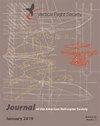Transient and Quasi-steady Numerical Simulations of Tiltrotor Conversion Maneuvers
IF 1.4
4区 工程技术
Q2 ENGINEERING, AEROSPACE
引用次数: 0
Abstract
The goal of this work is to characterize the ability of current numerical tools such as Comprehensive Analysis (CA) and computational fluid dynamics (CFD) to model the aeromechanics of a tiltrotor undergoing a transient conversion maneuver. First, a simplified model is used to quantify the differences in predicted loads between a simulation of a transient maneuver and those of several quasi-steady simulations. This analysis showed that quasi-steady simulations were an efficient and accurate method for modeling transient maneuvers. Next, the full XV-15 tiltrotor was studied using coupled CFD/CA quasi-steady and standalone CA transient maneuver simulations. Analysis and comparisons are made in terms of the rotor performance, trim, aerodynamic loads and interference, as well as the structural and vibrational loads. Nonlinear effects such as blade-wake interactions and aerodynamic interferences between the rotor and the wings were significant at the beginning and end of the conversion maneuver, respectively. As such, CA showed good agreement with CFD/CA at moderate airspeeds during conversion but struggled at low speeds and during cruise. Overall this work highlights the need for coupled CFD/CA analysis for capturing the complexities of tiltrotor conversion maneuvers. Coupled together, the simulations leverage the strengths offered by each tool and have the capability to accurately model the aerodynamic and structural dynamics of proprotors and tiltrotors at relevant operating conditions.倾转旋翼转换机动的瞬态和准稳态数值模拟
这项工作的目的是表征当前数值工具的能力,如综合分析(CA)和计算流体动力学(CFD)来模拟倾转旋翼机瞬态转换机动的空气力学。首先,采用简化模型量化了瞬态机动仿真与几种准稳态仿真预测载荷之间的差异。分析表明,准稳态仿真是一种有效、准确的瞬态机动建模方法。其次,采用CFD/CA耦合准稳态和独立CA瞬态机动仿真对全XV-15倾转旋翼进行了研究。从转子性能、配平、气动载荷和干涉、结构载荷和振动载荷等方面进行了分析和比较。在转换机动的开始和结束阶段,叶片-尾流相互作用和转子与机翼之间的气动干扰等非线性效应分别是显著的。因此,在转换过程中,CA在中等空速下与CFD/CA表现出良好的一致性,但在低速和巡航期间则表现出困难。总的来说,这项工作强调了需要耦合CFD/CA分析来捕捉倾转旋翼转换机动的复杂性。结合在一起,模拟利用了每个工具提供的优势,能够准确地模拟在相关操作条件下的旋翼和倾转旋翼的空气动力学和结构动力学。
本文章由计算机程序翻译,如有差异,请以英文原文为准。
求助全文
约1分钟内获得全文
求助全文
来源期刊

Journal of the American Helicopter Society
工程技术-工程:宇航
CiteScore
4.10
自引率
33.30%
发文量
36
审稿时长
>12 weeks
期刊介绍:
The Journal of the American Helicopter Society is a peer-reviewed technical journal published quarterly (January, April, July and October) by AHS — The Vertical Flight Society. It is the world''s only scientific journal dedicated to vertical flight technology and is available in print and online.
The Journal publishes original technical papers dealing with theory and practice of vertical flight. The Journal seeks to foster the exchange of significant new ideas and information about helicopters and V/STOL aircraft. The scope of the Journal covers the full range of research, analysis, design, manufacturing, test, operations, and support. A constantly growing list of specialty areas is included within that scope. These range from the classical specialties like aerodynamic, dynamics and structures to more recent priorities such as acoustics, materials and signature reduction and to operational issues such as design criteria, safety and reliability. (Note: semi- and nontechnical articles of more general interest reporting current events or experiences should be sent to the VFS magazine
 求助内容:
求助内容: 应助结果提醒方式:
应助结果提醒方式:


